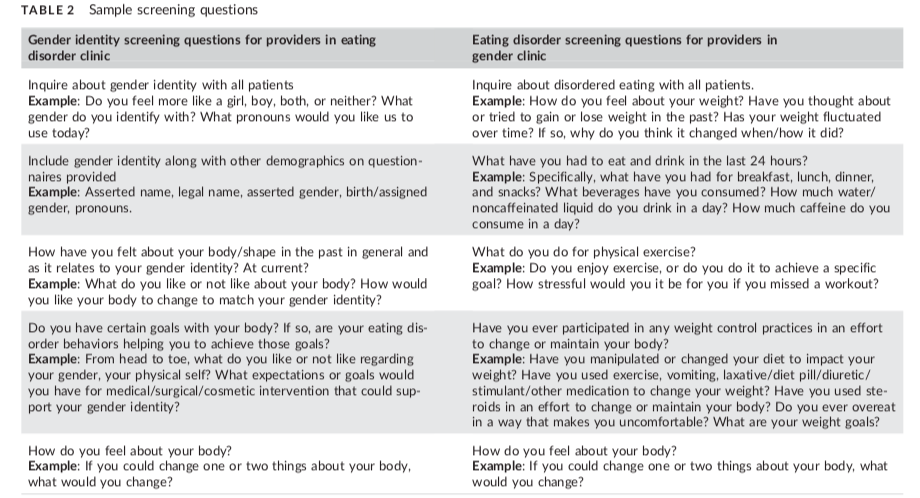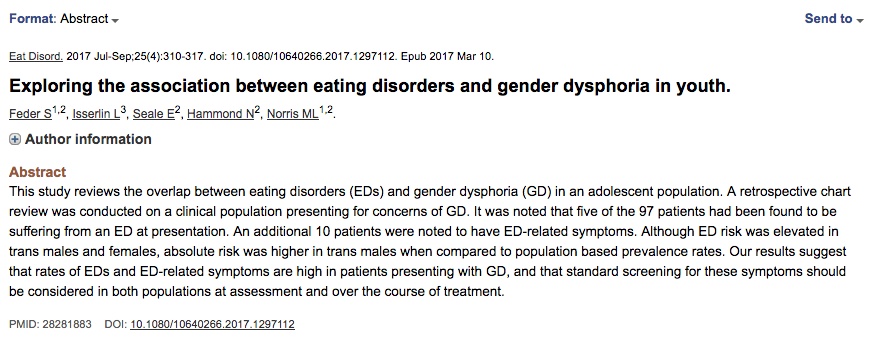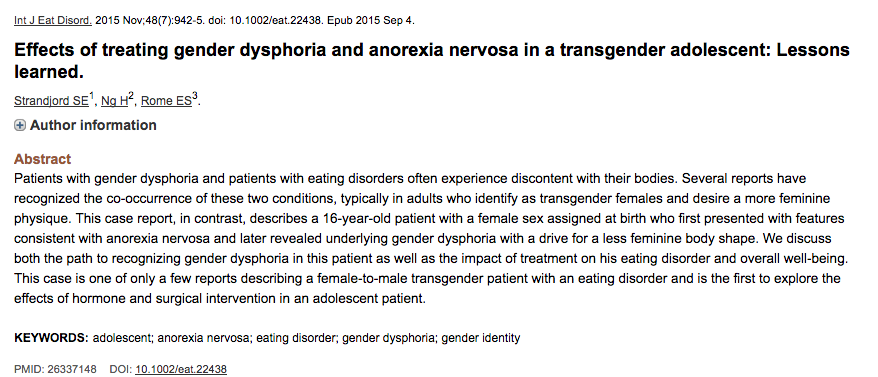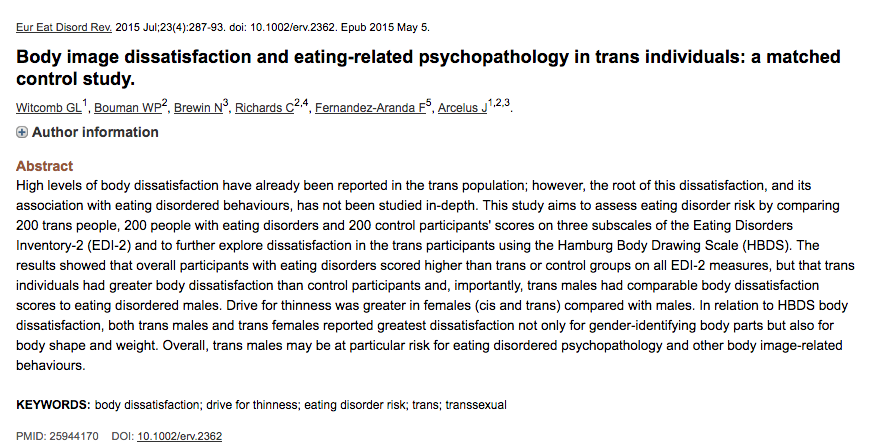Current thoughts: This is a work in progress from my UCSF Adolescent Medicine Rotation
Eating Disorders and Gender Dysphoria
Up until 2015 there was scarce adolescent literature correlating the prevalence or experience of gender nonconforming people who also suffer from an eating disorder; however, there are several parallels. Both have a dysphoria that focuses on and rejects the body of origin. Both are associated with psychiatric comorbidities and both populations have high levels of childhood trauma. Therefore, it is our job as adolescent medicine specialists to screen for and address disordered eating early and consistently with our differently gendered patients, and make space for our patients with eating disorders to also explore and manifest their unique genders.
Current literature from 2015-2018 including retrospective chart reviews, case series and case studies, and a metasynthesis of available qualitative research studies illustrate that there are some basic themes within these intersections.
“Identified themes include increased risk for self-harm/suicide, complex psychiatric, and medical implications of delay to treatment for either gender dysphoria or disordered eating, and the importance of collaborative management to maximize care and facilitate healthy development to adulthood. “
Transmasculine identified folks appear to be at a greater risk for concurrent restrictive eating and anorexia nervosa. This may be in an effort to “have a more angular body” as reported by one inpatient AN patient later identified with gender dysphoria and/or overt efforts to reduce or eliminate menses and breast development. Transfeminine folks with disordered eating have been found, in the small number of case studies that exist, to be more likely to experience AN with the traditional drive for thinness and a perceived beauty ideal.
Transmasculine and nonbinary people are showing up as more vulnerable to nonsuicidal self injury as well, as per a 2018 study exploring 3 longitudinal transgender cohorts under Project Affirm by Kasey Jackman NP from Columbia University. In their review self harm was revealed as “a mechanism of hiding the true self” and increased with greater gender incongruence and stress. Higher incomes and education levels were protective against these behaviors. Further research into understanding the lived experiences of transmasculine and nonbinary folks as well as new and improved medical and surgical gender affirming treatments are warranted as this population is clearly at risk for long term body dysmorphia and self injury.
Early awareness and recognition of these parallel conditions will improve patient outcomes if both gender identity clinicians and eating disorder specialists screen early and often for restrictive eating patterns, binging and purging behaviors, and gender incongruence or dysphoria in all settings including medical and psychiatric inpatient hospitalizations.
 From Donaldson AA, Hall A, Neukirch J, et al. Multidisciplinary care considerations for gender nonconforming adolescents with eating disorders: A case series. Int J Eat Disord. 2018;51:475–479. https://doi.org/10.1002/eat.22868
From Donaldson AA, Hall A, Neukirch J, et al. Multidisciplinary care considerations for gender nonconforming adolescents with eating disorders: A case series. Int J Eat Disord. 2018;51:475–479. https://doi.org/10.1002/eat.22868
One difference between Eating Disorders with and without gender incongruence is the former can be treated with pubertal blockade, cross sex hormones and surgical intervention; these treatments may relieve some dysphoria triggering the restrictive eating or purging, at least temporarily. Several case studies of transgendered youth evidenced the ability able to restore and maintain weight with the initiation of appropriate gender focused medical interventions for their chosen identity. However, eating disorders do have a high relapse rate and at least one patient slipped back into restrictive and disordered eating with compulsion to exercise with life stressors. Therefore, ongoing screening and open discussion with each patient is important for long term wellness.
REFERENCES:
Bethany Alice Jones, Emma Haycraft, Sarah Murjan & Jon Arcelus. Body dissatisfaction and disordered eating in trans people: A systematic review of the literature. Pages 81-94 | Received 14 Aug 2015, Accepted 27 Aug 2015, Published online: 30 Nov 2015
Sarah E. Strandjord BS , Henry Ng MD, MPH , Ellen S. Rome MD, MPH . Effects of treating gender dysphoria and anorexia nervosa in a transgender adolescent: Lessons learned.First published: 04 September 2015 https://doi-org.une.idm.oclc.org/10.1002/eat.22438
Stephen Feder, Leanna Isserlin, Emily Seale, Nicole Hammond & Mark L. Norris (2017) Exploring the association between eating disorders and gender dysphoria in youth, Eating Disorders, 25:4, 310-317, DOI: 10.1080/10640266.2017.1297112
Donaldson AA, Hall A, Neukirch J, et al. Multidisciplinary care considerations for gender nonconforming adolescents with eating disorders: A case series. Int J Eat Disord. 2018;51:475–479. https://doi.org/10.1002/eat.22868






